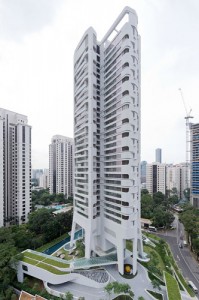
(Ardmore Residence, Singapore, UNStudio)
“Tradition does not mean guarding the ashes, but fanning the embers,” observed Benjamin Franklin; similar quotations are attributed to Thomas More and Gustav Mahler. Guarding the ashes puts old fogies in their place, and fanning the embers nicely catches the sense of an active involvement with the past. One looks in vain for such involvement in much of today’s architecture. Too many architects have embraced novelty as the sine qua non of new work, perhaps under the mis-impression that they are designing products rather than buildings. But while the life of an iPhone is too short for the novelty to ever wear off, a few years at most, the life of buildings is not measured in years but in centuries. A building that merely offers the new-new thing, quickly become old-fashioned, or worse, out of fashion. Buildings that fan the embers of the past, by contrast, incorporate rich layers of meaning. During a recent visit to Louis Kahn’s Kimbell Art Museum, the interior with its vaulted ceilings reminded me both of older art galleries and of ancient architecture. Because Kahn ignored the fashions of his day, his building continues to look fresh; because he observed the old conventions—symmetry, axes, a structural grid, top-light—his building suggests several time dimensions: today, 1972 when it was built, and a long, long time ago.

As I live fairly near the Ardmore Residence in Singapore that you feature in the picture attached, I have to say that Singapore doesn’t measure Buildings in Centuries.
They measure them in decades.
Maybe.
Perhaps that contributes to the soulless character often ascribed to this country. With a feeling that nothing lasts, why care?
Also, you can rent a lovely 3 bedroom in the Ardmore for only $19k a month.